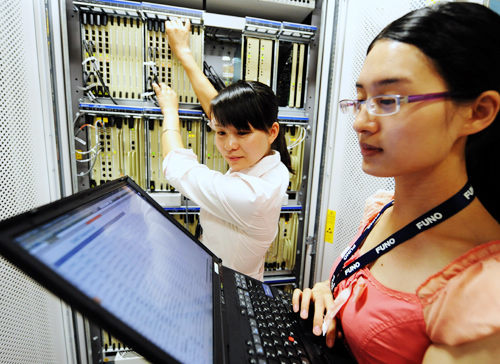|
 |
|
FAST TRANSPORTATION: Workers at a post office delivery branch in Nanjing, Jiangsu Province move packages in their warehouse (SUN CAN) |
However, the "re-industrialization" idea proposed by the United States and some European countries has not been effectively implemented. The development of new energy, low carbon, and new generation of information technology industries is proceeding slowly. "Without major scientific and technological innovation, or without the revitalization of the real economy, developed countries might fall into a prolonged period of depression, which would cripple China's exports," said Li.
Domestically, imbalanced, uncoordinated and unsustainable industrial development remains a major headache. First of all, further expansion of consumption and upgrades of the consumption structure face a lot of restrictions. Urbanization remains the inner push for China's economic growth. But urbanization is confronted with a number of obstacles such as the rise of living expenses, employment pressure, increasing gap between urban and rural incomes and the imperfect social guarantee system. Second, China's traditional comparative advantage is being dented due to the skyrocketing prices of land, labor, raw material and fuel. In addition, carbon emission reduction requests will put pressure on China's economic and social development. Third, structural problems, such as excess capacity and outdated capacity in certain industries, still exist. The slow development of the scale of economy, backward development of a productive service industry and improper industrial production arrangements are haunting economic development. Those are the major barriers clogging China's industrial development.
"Internal and external conditions for the demand structure, production cost and international trade are making rapid changes. Speeding up industrial restructuring and pushing forward economic structure readjustment have become the most important strategic choice for China," said Li. "If we fail to adapt to the new round of global technology reform and industrial restructuring, we may lose the new development opportunity."
China should consider the following questions before it takes on a major change in economic development. How to turn the past extensive development mode into an efficiency-oriented intensive one? How can China develop an economy led by innovation and efficiency? How can Chinese companies adapt themselves to the restructuring?
Gu Qiang, Deputy Director of the Planning Department of MIIT, said the top priority is to make breakthroughs in core technology.
"Even though it takes a long time, achieving technology innovation and breakthroughs is the core of the industrial upgrade," said Gu.
Gu said the green industry should be the major power driving economic growth. At present, the world economic slowdown makes export expansion a mission impossible. In the meantime, although domestic consumption is making an increasing contribution to economic development, an excess reliance on consumption for economic growth is not a good way either.
"I believe our economy should be driven by green technology and our economic growth should be achieved in a greener way," said Gu.
Gu said in terms of carbon emission reduction and energy conservation, the government has made proper regulations. Green does not refer to emission reduction only, as the reduction itself may spur emergence of new industries. For instance, in cloud calculation, the most important part is energy conservation.
Li of the CFIE said China should increase support to technology innovation in emerging industries, building up a number of high-level technology innovation infrastructure and speeding up industrialization of new technologies.
China should also focus on new ways of doing business by promoting professional services and value-added services. New channels and platforms must be built for new industrial products to enter into the market.
Li said the development of the service industry that promotes industrial restructuring and upgrading should be given enough attention so that it may provide strong support to industrial restructuring. The service industry may include industrial design, modern logistics, information service, software industry, science and technology management consultancy and business process outsourcing. | 